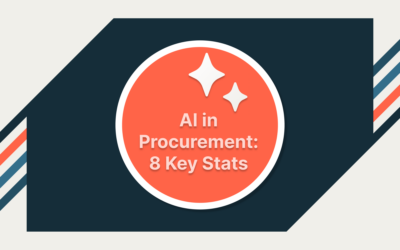In a market with many different choices, assessing the value of procure-to-pay software becomes even more important when making a purchase — but it’s often difficult to wade through the avalanche of information, all of it claiming significant ROI.
That’s a situation Airbase CEO, Aneal Vallurupalli, has faced in the past. Speaking at a recent Airbase webinar with guest speaker Amy Harrison, Senior Consultant at Forrester, titled “How to Quantify the Value of Procure-to-Pay Software,” Aneal said: “It’s incredibly important to understand the quantifiable financial value of what we’re going to be purchasing, and implementing and spending a lot of time with. But it’s challenging to get reliable data.”
The Forrester Total Economic ImpactTM (TEI) study commissioned by Airbase offers an impartial third-party way to assess the value of procure-to-pay software. Forrester, a leading analyst firm, has developed a proprietary methodology based on verified financial data. Amy Harrison, Senior Consultant at Forrester, joined Aneal to explain the process of putting together a TEI study to measure the value of procure-to-pay software.
For the Airbase TEI study, Forrester Consulting obtained financial data from an Airbase customer for the analysis. But their findings don’t just quantify Airbase’s ROI. They also speak of the value of an entirely new approach to managing accounts payable.
“Results tell a much larger story on how automating procure-to-pay and close cycles can really materially impact your bottom line,” says Amy. “Our analysis can get you thinking about building your own business case.”
Key components of assessing ROI.
The TEI study stands out because it looks at cost and benefits, as well as future benefits and risk. The four major components of the analysis are:
- Benefits
- Cost
- Flexibility
- Risk
Amy explained that it’s important to remember that benefits can be both quantifiable and non-quantifiable. Flexibility refers to the options an investment made today may offer in the future.
Amy says with regards to risk:
“We want to make sure this is as credible as possible. This is where we take off the rose-tinted glasses and pressure-test our assumptions mathematically. In reality, this means we decrease the benefits and increase the cost numbers to make sure the analysis is as conservative and defensible as possible.”
Methodology for assessing ROI.
“We do a lot of due diligence in the beginning,” says Amy. “We talked to Airbase subject matter experts, but also with Forrester analysts. They give us a good understanding of what they’re hearing from the market, in order to give it the sniff test.”
Forrester then interviewed a senior accounting leader from an organization that had used Airbase since 2022.
It’s important to note that the results of the study are impartial. “We retain editorial control to ensure this is an objective, third-party study,” Amy stresses.

Guided Procurement Tour
Explore our automated procurement workflows in the Guided Procurement tour.
Benefits driving ROI.
When evaluating the ROI of the P2P platform, Forrester focused on these five quantifiable benefits:
- Cash back from cards.
- Labor cost savings.
- Savings due to increased expense policy compliance.
- Increased profit from vendor management.
- Retired legacy solutions.

Cash back benefits.
Forrester’s analysis found that the study subject is an excellent example of using corporate cards to generate revenue on a consolidated platform. It all added up to $209,896 in generated revenue over three years.
“Airbase has paid for itself. We knew we were going to have to spend the money on a procure-to-pay system, but an added bonus was that it could pay for itself.” Senior accounting leader, financial services.
Labor cost savings.
Amy says Forrester found that the study subject successfully leveraged the power of AP automation for real savings. Over three years, they saved $448K on an NPV basis, largely due to automating previously manual processes.
“There were so many real-world examples of how they created efficiencies,” she said. “No more manual headaches. A lot of that manual time was eliminated.”
The client identified many functions that saved hours of labor, including automated approval workflows,
“My team is happy, works fewer hours, and we have better retention.” — Senior accounting leader, financial services.
Savings due to expense policy compliance.
Amy had high praise for the disciplined spend culture that developed after implementing Airbase. She noted the increased awareness of spend policy acts as a deterrent for employees who might otherwise submit non-compliant expenses. And any expenses that are submitted are instantly flagged through the approval process.
Implementing Airbase triggered the establishment of enforceable policies that aligned with company objectives, allowing the company to examine existing processes and policies, and make modifications that reflect their growth and goals.
“Procure-to-pay and travel expenses are under one roof, and It’s really allowed us to comply with and develop more internal policies to make us a more disciplined company.” Senior accounting leader, financial services.
That’s a significant development — and it all added up to $122K NPV.
Vendor relationships.
Vendor relations have an often underappreciated impact on a company’s bottom line, so it’s important to include the success of vendor management tools in an ROI assessment.
“What we’re qualifying with this benefit is what is the impact if those invoices aren’t paid and you develop an unhealthy relationship with vendors. It can really impact your relationship,” says Amy.
Poor vendor communication can have a ripple effect across a company. Amy named an example of a company where a contract amendment slowdown took too long to sign, which resulted in a three-month delay in getting product to market. In other words, the company missed out on potential revenue all because the procurement process wasn’t keeping up with the rest of the company.
“These are the real impacts of inefficient operations,” says Amy.
The client studied in the TEI study was able to cut their procurement cycle times from 48 days to 26 days, with a goal to reduce that timeline even further.
Retired legacy solutions.
The company studied in the TEI study specifically looked for a procure-to-pay solution that offered payment cards. Once Airbase was implemented, they could easily phase out their clunky legacy expense and AP automation solutions. That saved $60K NPV.
“The efficiencies we’ve gained are tremendous because we put everything under one roof and we don’t have to manage this old clunky system. It’s been tremendous for my team because we just don’t spend time trying to figure out who needs to approve invoices.” Senior accounting leader, financial services.

Benefits that can’t be quantified.
Amy explained that it’s also important to consider the benefits that Forrester couldn’t put a hard number against but that still represented real value. Those benefits ultimately contribute to the success of any P2P platform.
Key intangible considerations include:
- Improved negotiation position. Prior to Airbase, the team didn’t have visibility to monitor procurement. “You need to know where you’re going and where you’ve been to be in a negotiating position,” says Amy.
- Increased time to support business operations. One of the most exciting things for the finance team has been new opportunities to do more strategic work, now that the more routine tasks are automated. “There’s a downstream impact of invigorating the team,” says Amy.
- Increased accuracy in financial statements. Not having to make adjustments or correct errors saves time, and is ultimately good for morale.
- Strong internal controls improved risk mitigation. “This ties in well with improved risk mitigation,” says Amy. “Without internal controls, you’re open to missing things, you’re open to being vulnerable.”

The cost side of the equation.
Of course, in addition to the benefits of a P2P system, you need to consider the costs. Amy explained that Forrester grouped the costs into two categories: the onboarding and licensing fees paid to Airbase, and the internal costs associated with deploying Airbase. Fortunately, the team required minimal training, thanks to Airbase’s ease of use, but they did spend time planning the implementation.
The impact of a 272% ROI.
The final ROI of 272% is significant. But to the study subject, it’s more than just a number — they believe it’s a sign of the company’s growing maturity. Airbase supported operations as they grew rapidly, and has set the foundation for future growth, with greater control.
“We went through that really fast growth stage and were very narrowly focused on growth with less business discipline. When you hit the apex of that growth stage, you have to say, ‘Hey, now it’s time to grow up as a business and start following policies and procedures, start having controls in place and so forth.’ Airbase did a good job of helping us get there.”
 Jira Integration – Streamline Your Workflows
Jira Integration – Streamline Your Workflows  Ironclad Integration – Simplify Legal Operations
Ironclad Integration – Simplify Legal Operations  Asana
Asana 




